Audio Mirror 6AS7
PSE 20 wpc monoblocks
These
Audio Mirror 6AS7 PSE mono-blocks have
been my true workhorses for more than four years
now (2010) and are likely to stay so for years to
come. They are reliable and have never caused me
trouble. Changing the coupling caps improved
transparency considerably and with the mods shown
below, these monoblocks are serious contenders to
my 300B SET amp and I use them all the time for
my DTQWT
speakers. In fact, I find these amps so good I
have ordered teflon tube sockets and they are
regularly on the test bench for further
refinements as shown below.
Tweaking these amps over and over again may
suggest the initial construction is somewhat
flawed, but this is not the case. Making a living
from producing specialty products for the hifi
community is probably any bit as difficult as
producing large horn speakers. There's an
enormous interest in exotic gear and getting the
very best the industry can offer, but try make a
low-wattage SET amp from the very best components
and see if you can sell it... We like to drewl
over these cost-no-object products, but when it
comes to buying it, we usually settle for less.
So, these amps come with decent caps, tube
sockets, etc., and it's up to us to spend further
money in refinement, once the initial bill is
paid. |
Once and a while
we may come across components that just stay put
in our system for years and years. Not because
they are the very best sounding gear around, but
because the overall performance, appearance and
not least daily handling makes you feel good. I
was seriously thinking of building a PSE from
300B tubes two years ago, but would it really
sound significantly better? Probably not much. I
also cherish a product where money seems to have
been well spent. All transformers here are wound
for handling also the 6C33 tubes delivering some
50 watts, thus fairly oversized. The stainless
steel chassis doesn't easily get scratched and
it's easy to clean and so are the acrylic side
panels. Changing speakers and amps is something I
do regularly and I need gear that's easy to
handle and doesn't take cotton gloves every time
I rearrange my set-up. The same goes for my
Garrard 401 turntable, which makes me feel good
by looks and handling - and not least sound.
I had Vladimir Bazelkov
adding 4 ohms speaker taps and a switch for 500
mV and 1000 mV input sensitivity. These
mono-blocks run by Transcendent GG line stage at
500 mV input sensitivity made an excellent match,
significantly better compared to my previous
Audio Research SP16L line stage - until I tried
the 5687/7119/6N6P
w.o.t. line stage. This
line stage, finally finished summer 2009, lifted
the sound quality even further and these two
components now form the core of my system,
supplemented by a Transcendent RIAA + SAC MC
trafos.
All tubes for the AM
mono-blocks are readily available - and
at low cost. I have a range of 6SL7 and 6SN7
tubes but can't hear noticeable differences. I
recently bought five 6AS7 out-put tubes from
China (eBay - google 6AS7) and they sound as good
as the Russian tubes originally supplied. 8
$/ea.... doesn't come much cheaper than this. A
seriously oversized output transformer may be
part of the good sound and potent bass these amps
can deliver. I've had a number of visitors in for
comparing my 300B and Audio Mirror amps and they
always prefer the Audio Mirrors and I'm sure the
AMs win due to the 20 watts compared to the 8
watts from the 300B. There's more punch and drama
from the AMs, where the 300Bs deliver that
special 300B sound that becomes addictive.
(BACK
TO TOP)
|
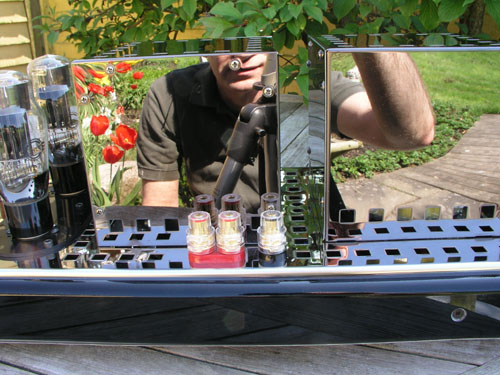 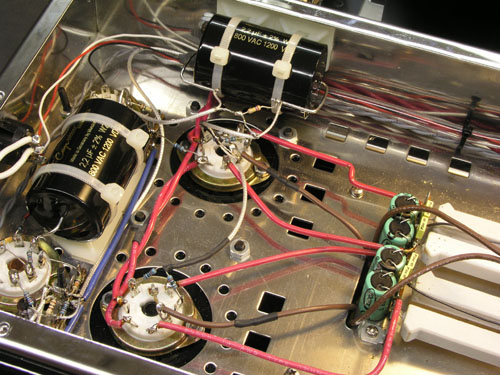
Mundorf
silver/gold/PP coupling caps. These caps are huge - and
unnecessary I later found out. 100 nF and 220 nF can do.
Even 40 and 80 nF is enough should you want to try out
some Russian silver/micas as shown later.
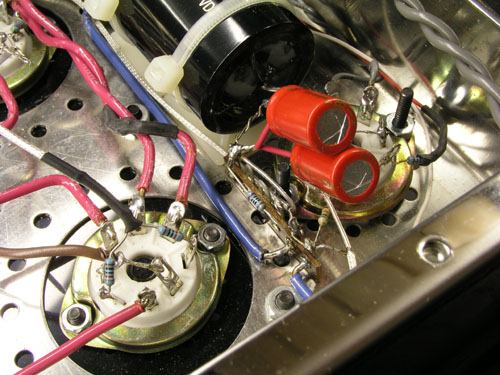 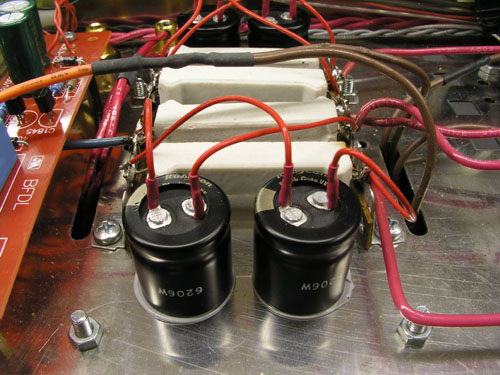
Left:
Black Gate type N for input stage cathode by-pass, 2 x
100 uF/16 V non-polarized.
Right: Black Gate VK by-passing cathode resistors, 22
uF/350 V.
Audio
Mirror schematic, amplifier stage
(BACK TO
TOP)

Audio
Mirror 6AS7 PSE amplifier stage. After changing to DC
filament supply all the 100 ohms resitors
seen above were removed and 100 oms resitors were
connected from filament minus to ground. See below.
|
The
switch at 6SL7 cathode resistor provides either
500 or 1000 mV sensitivity. I removed this and
used the switch for shorting the input when
needed (convenient when change of preamp, etc.)
The amp comes with 2 uF coupling caps, which is
rather excessive. Between 6LS7 and 6SN7 we can
get along with 220 nF, providing an F3 of 5 Hz.
Between 6SN7 and 6AS7 tubes we can do with 100
nF. I actually tried 40 nF Russian Micas and it
works fine, actually I'm not sure these Micas
aren't as good as the excessively expensive
Mundorf silver/gold/PP caps.
Not having a decoupling cap after 2k2 at 6SL7
must be an error from the constructor. 22uF/350V
BG was inserted.
The schematics shown here
is without any guarantee and I'll see if I can
work out the power supply section, which is bit
more tricky as it's partly a PCB set-up. So
please do not ask how it looks.
The
mains trafo has two taps for filament supply.
12.6 V for the 6AS7 out-put tube coupled in
series and 6.3 volts for the input/driver tubes.
I made these into DC to reduce noise, which
really didn't help much I must say. Not that hum
is a problem here, but we can always try to
improve things if possible. The 100 ohm resistor
from V2/pin8 to ground was removed. All filament
supplies' negative was connected to ground via
100 ohms.
Input
phono sockets' ground connection were insulated
from chassis and power supply's central ground
was connected to chassis via 10 ohms resistor.
The
HT rails are delayed 90 sec. after turn-on.
The
mains trafo also has a 100 volt tab (for negative
bias) not used in the 6AS7 version, which points
to the fact that the 6C33 (2 x 40 watts) version
of this amp uses the same mains transformer and
output transformer as this 20 watt version.
I
feel certain the output transformer has 600 ohms
primary winding. Output taps for 4 and 8 ohms. I
actually never use the 4 ohms taps.
Future
tweaks:
New teflon sockets for all tubes and complete
rewiring of amp.
Kiwame resistors for signal paths.
Move on-off switch to rear of amps (having 230
volt right next to the input stage is not ideal)
Further coupling cap tests, VCaps?, Mundorf
silver/gold/oil?, tin/teflon? Hard to tell where
it ends. Trying some "no-cost" Russian
silver/micas has made me wonder whether I really
need to spend 300 USD on super caps...
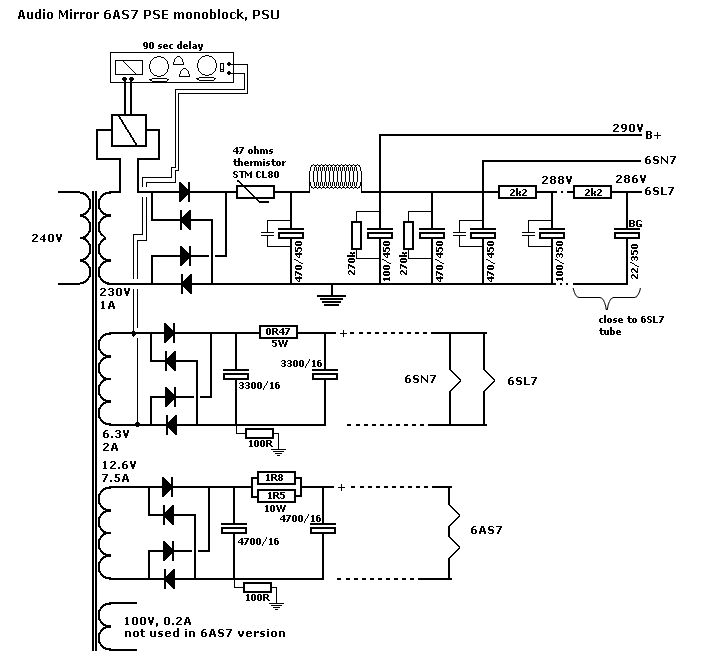
Power supply schematics - including my mods (DC
filament supply).
As can be seen the power supply is hugely
overdimensioned, e.g. 230 watts for a 20 watts
amplifier!
|
Caps - the necessary evil
(BACK TO
TOP)
Before
starting the above list of modifications, I took
another round of cap tests. Once more the green
Russian PIO caps were in and they really are nice
and easy to listen to. Overall smooth sound given
the price, but somewhat lacking in level of
transparency and detail. Tonal balance is good,
but knowing there is something better on all
parameters just doesn't leave them much chance.
Trying the Russian FT3 alu/teflon caps was out of
the question. I don't think they're that great
and the choice of caps here is a cost-no-object
issue, except for some ridiculously expensive
Jensen silver caps.
What's needed is 2 x 100 nF and 2 x 220 nF, even
smaller values can do. The new SCR tin/teflons
are 250 USD for the four caps. VCaps are 278 USD,
only a little more than the SCRs. Mundorf Supreme
silver/gold/oil is 241 USD (prices from VHAudio
(US), HiFiCollective (UK) and Strassacker (DE).
Jensen silver would make 675 USD for comparison.
I find 250 USD for the very best caps acceptable,
considering the cost of the amps. |
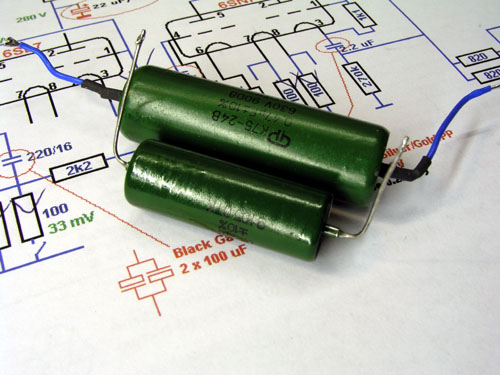 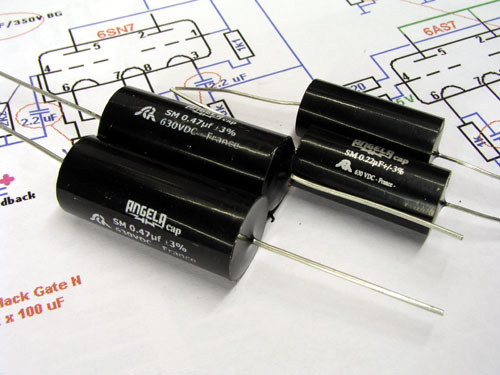
Left:
Russian PIOs. Right: New Angela tin foil/PP made by SCR
(Solen).
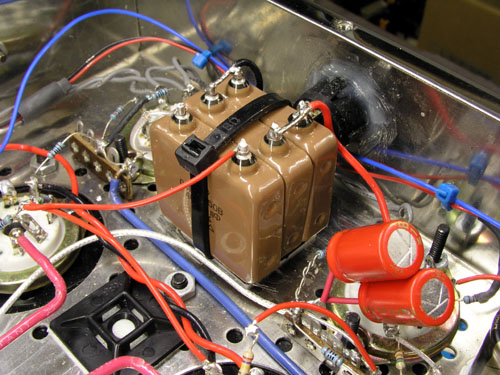 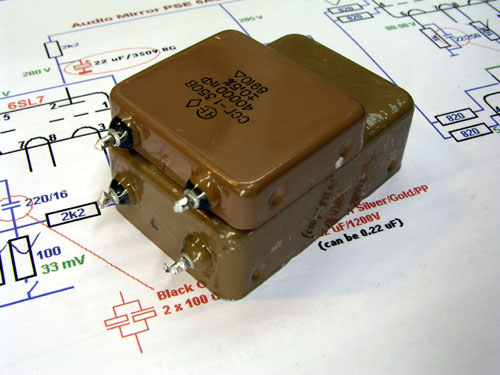
|
After
the green Russian PIOs, I dug up my Russian
silver/micas again. The AM amps can really do
with only 40 nF and 80 nF, so I paralleled two 40
caps for the first stage. These silver micas cost
nothing; that is e.g. 18 USD for 8 x 40 nF. Now,
18 USD is not exactly even close to 250 USD, but
how about the sound? The midrange is very close
to the VCaps - and maybe even better. They
deliver a scaringly presence quality that
initially made me think they had a slightly
veiled treble performance, but that isn't so. The
depth of the soundstage may seem a little shorter
compared to the Mundorfs, but every time we try
out something significantly different from what
our ears have been used to for months, we have to
adjust our attention and question ourselves what
it was we were listening to before. Because there
is no right here, only compromises.
Having
received the Obbligato (SCR) tin-foil/teflon caps
I quickly inserted these and even out-of-the-box
they immediately made it clear that we here have
an exceptionally good product. What they do in
comparison to the silver/micas is clearing up the
treble range. I never really could decide what I
should say about the treble performance of the
silver/micas but they do smear treble detail a
tiny bit in comparison with the SCRs, that is,
when they have to handle complex signals like a
full symphonic orchestra. With less complex
music, the difference is hard to tell.
I
have been using the Mundorf silver/gold/PP in
many applications and I like them. The level of
transparency is excellent, and except for at
slight emphasis on the two top octaves, which in
certain applications can make them sound a bit
hard, I couldn't ask for more.
The VCaps I only know from my 300B amp and when I
use the VCaps I miss the Mundorfs and visa-versa.
The VCaps are smooth and detailed and do not have
the Mundorf silver/gold/PP treble emphasis. The
VCaps are simply more right, I think.
The
final choice was the SCR tinfoil/teflons as can
be seen below.
|
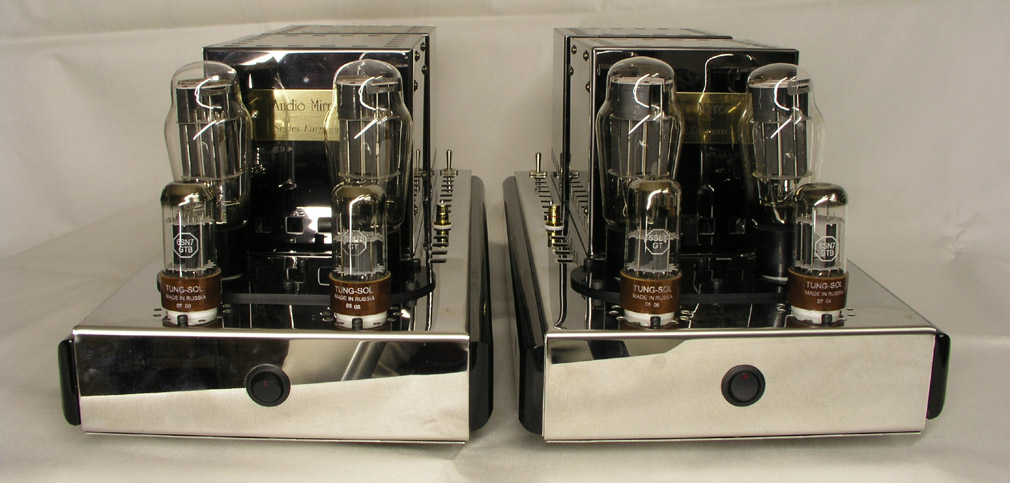
Audio
Mirror Rebuild
2009
(BACK TO
TOP)
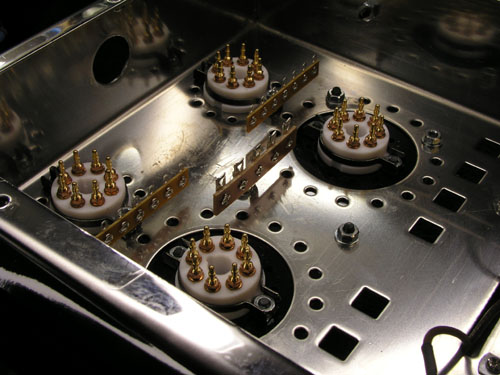 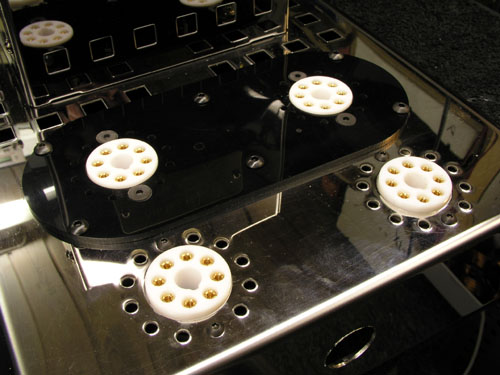
Cleaning up the amplification stages takes
like an hour. Rebuild . . . many late night hours. New
sockets and soldering tag strips in place.
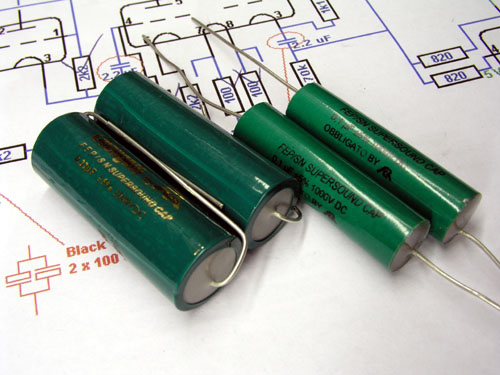 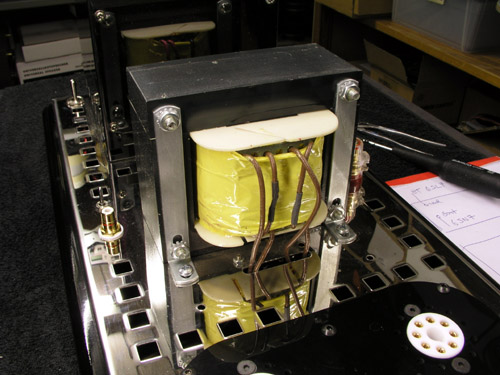
Left:
SCR tinfoil/teflon coupling caps. Right: Massive output
transformer for only 20 watts.
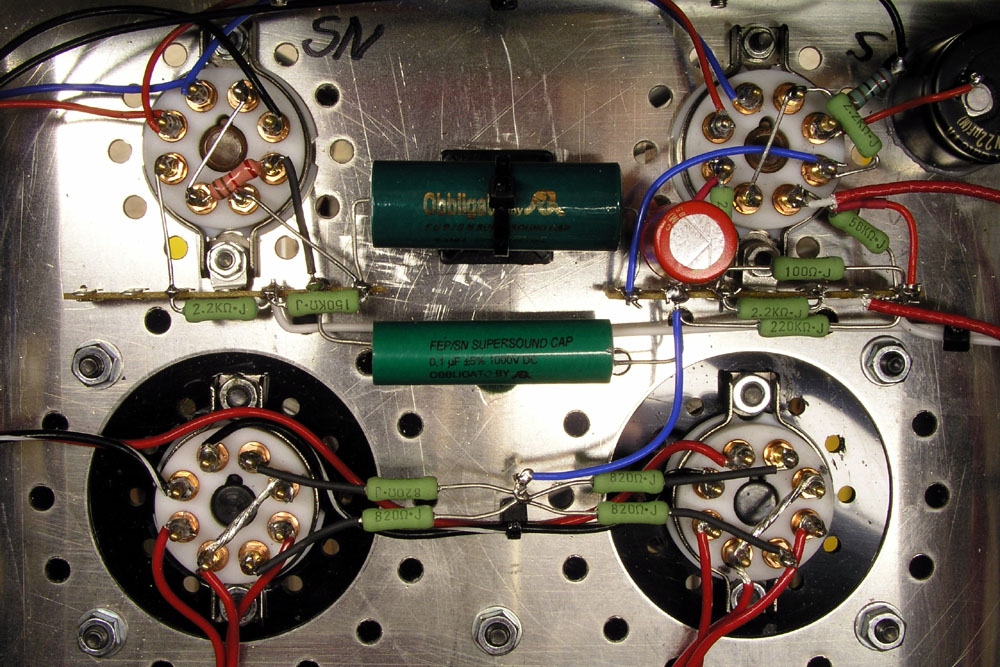
Kiwame
resitors for signal, metal film for HT supply. All silver
plated copper in teflon wire and cables.
Now: Time for some music. AM mods will be
over for this time.
Future: Possibly rebuild power supply section.
|